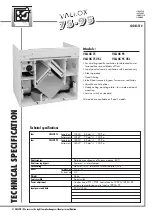
3.5.1 Information on setting up fans that
are installed outdoors
3.5.1.1
Penetration of precipitation
Centrifugal roof fans
Fans from the ViVent, Minivent, DRH, DRV, DRVF, BVD
and BVW-D series are suitable for use in standard
weather conditions that normally occur. In rare cases,
rain can enter the building in extreme, stormy condi-
tions. Particular installation conditions and locations,
such as near the coast or tall freestanding buildings,
can be beneficial in these circumstances.
In the case of roof fans with vertical blow-out, the pene-
tration of precipitation into the fan casing is permitted for
function-related reasons. Existing drain holes in the
lower part of the casing are used to drain off the pene-
trating precipitation.
3.5.1.2
Formation of condensation
Uninsulated building penetrations are generally avoided
and should be insulated by others. Uninsulated fan
parts or accessory parts which can have different out-
side and inside temperatures and which cannot exclude
the formation of condensation must be insulated by
others following assembly (min. 20 mm-thick insulation
e.g. made of mineral wool or comparable insulation
materials). The fire safety engineering requirements
must be observed.
3.5.1.3
Stability
Particular installation conditions and locations, such as
near the coast or freestanding buildings, may require
certain safety measures. (stability, prevention of proper
motion). The safety measures can be implemented by
means of suitable restraints.
3.5.1.4
Penetration of foreign matter
The blow-out casings of the roof fan types have a con-
structive protection against ingress of foreign matter and
animals. Optionally, an additional cover grille can be
attached to the types DRV/DRVF/DRVF-H/BVD. Gener-
ally speaking, corresponding protective equipment (e.g.
cover grille) must be attached to free-outlet and free-
inlet fans.
3.6 Operating modes
3.6.1 S1 continuous operation
The fans are designed for continuous operation (S1
operating mode according to DIN EN 60034-1).
3.6.2 S9 speed-controlled operation
General
Fans are speed-controlled to adjust the operating point
to the system and utilisation requirements.
Speed control, maximum speed
The maximum speed specified on the rating plate must
not be exceeded.
Measures in the case of natural frequencies
Mechanical components have natural frequencies that
can cause the components to fail if accelerated to
impermissibly high vibrations. There is a possibility that
casing parts, bearings, crankshafts, attachments and
impellers can be damaged.
Excitation frequencies are, for example, caused by the
impeller’s rotary frequency, the blades’ frequency, the
blades’ rotational frequency, the motor’s rotary fre-
quency or aerodynamically.
If the excitation frequency is exactly or practically the
same as a component’s natural frequency, resonance
frequencies that can cause the component to fail will
occur. The excitation forces are dependent on the com-
ponents’ balancing condition, true running characteris-
tics, aerodynamic forces and damping features.
DANGER!
Danger due to resonance frequencies!
The fan must not be operated in the higher speed
range in which increased vibration values occur.
These areas must be skipped or removed for the
operation. The areas must be passed through so
quickly that the permissible vibration values in the
resonance frequency are not engaged or exceeded.
A permanent vibration monitoring system is recom-
mended for speed-controlled fans to ensure the long-
term, safe operation of the fan.
After commissioning speed-controlled fans, it is
common practice to initially start them with short mainte-
nance intervals, and if no damage occurs, to gradually
adjust the maintenance intervals to the intervals speci-
fied in the operating manual.
Commissioning of speed-controlled fans
During commissioning, the fan vibrations must be
checked over the entire speed control range of the fan.
During this process, the vibrations on the casing and
bearing must be determined and evaluated in accord-
ance with DIN ISO 14694 depending on the installation
and motor rating. Refer to the “Vibration velocities” table
in the appendix of the operating manual for the permis-
The amplitude of the vibration velocities is dependent
on different factors.
Technical data
Operating modes > S9 speed-controlled operation
Centrifugal roof fans DRH; DRV; DRVF; DRVF-H; BVD; BVD(F600)
18
Содержание BVD F600
Страница 47: ...Appendix Appendix Centrifugal roof fans DRH DRV DRVF DRVF H BVD BVD F600 47...
Страница 61: ...Centrifugal roof fans DRH DRV DRVF DRVF H BVD BVD F600 61...
Страница 62: ...Centrifugal roof fans DRH DRV DRVF DRVF H BVD BVD F600 62...
Страница 63: ...Centrifugal roof fans DRH DRV DRVF DRVF H BVD BVD F600 63...
















































